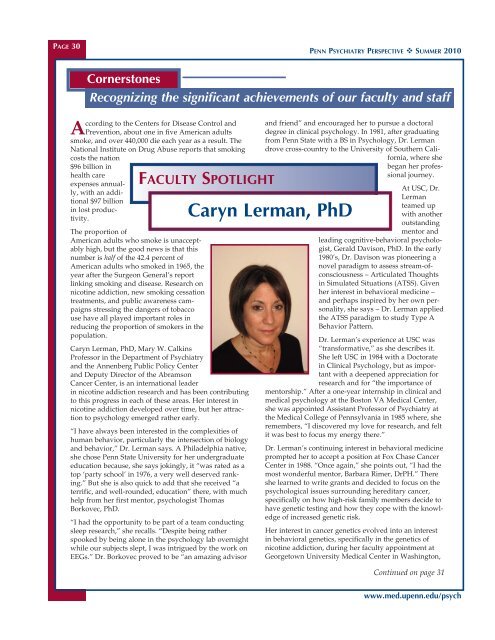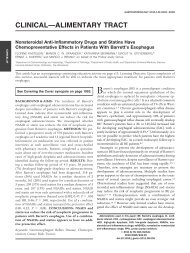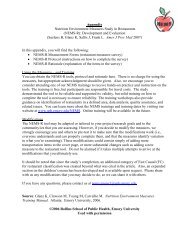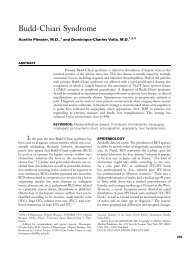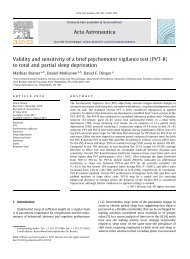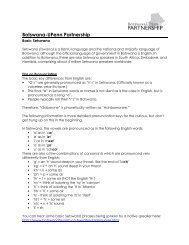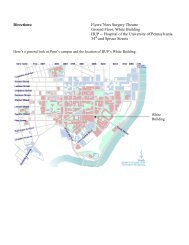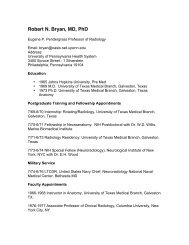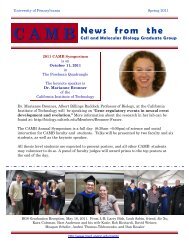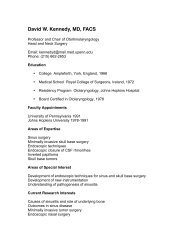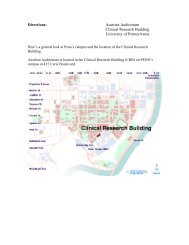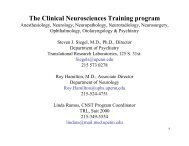PPP_Summer 2010_EDITED FINAL 072010:PPP.qxd - University of ...
PPP_Summer 2010_EDITED FINAL 072010:PPP.qxd - University of ...
PPP_Summer 2010_EDITED FINAL 072010:PPP.qxd - University of ...
Create successful ePaper yourself
Turn your PDF publications into a flip-book with our unique Google optimized e-Paper software.
PAGE 30<br />
Cornerstones<br />
PENN PSYCHIATRY PERSPECTIVE � SUMMER <strong>2010</strong><br />
Recognizing the significant achievements <strong>of</strong> our faculty and staff<br />
According to the Centers for Disease Control and<br />
Prevention, about one in five American adults<br />
smoke, and over 440,000 die each year as a result. The<br />
National Institute on Drug Abuse reports that smoking<br />
costs the nation<br />
$96 billion in<br />
health care<br />
expenses annually,<br />
with an additional<br />
$97 billion<br />
in lost productivity.<br />
The proportion <strong>of</strong><br />
American adults who smoke is unacceptably<br />
high, but the good news is that this<br />
number is half <strong>of</strong> the 42.4 percent <strong>of</strong><br />
American adults who smoked in 1965, the<br />
year after the Surgeon General’s report<br />
linking smoking and disease. Research on<br />
nicotine addiction, new smoking cessation<br />
treatments, and public awareness campaigns<br />
stressing the dangers <strong>of</strong> tobacco<br />
use have all played important roles in<br />
reducing the proportion <strong>of</strong> smokers in the<br />
population.<br />
Caryn Lerman, PhD, Mary W. Calkins<br />
Pr<strong>of</strong>essor in the Department <strong>of</strong> Psychiatry<br />
and the Annenberg Public Policy Center<br />
and Deputy Director <strong>of</strong> the Abramson<br />
Cancer Center, is an international leader<br />
in nicotine addiction research and has been contributing<br />
to this progress in each <strong>of</strong> these areas. Her interest in<br />
nicotine addiction developed over time, but her attraction<br />
to psychology emerged rather early.<br />
“I have always been interested in the complexities <strong>of</strong><br />
human behavior, particularly the intersection <strong>of</strong> biology<br />
and behavior,” Dr. Lerman says. A Philadelphia native,<br />
she chose Penn State <strong>University</strong> for her undergraduate<br />
education because, she says jokingly, it “was rated as a<br />
top ‘party school’ in 1976, a very well deserved ranking.”<br />
But she is also quick to add that she received “a<br />
terrific, and well-rounded, education” there, with much<br />
help from her first mentor, psychologist Thomas<br />
Borkovec, PhD.<br />
“I had the opportunity to be part <strong>of</strong> a team conducting<br />
sleep research,” she recalls. “Despite being rather<br />
spooked by being alone in the psychology lab overnight<br />
while our subjects slept, I was intrigued by the work on<br />
EEGs.” Dr. Borkovec proved to be “an amazing advisor<br />
FACULTY SPOTLIGHT<br />
and friend” and encouraged her to pursue a doctoral<br />
degree in clinical psychology. In 1981, after graduating<br />
from Penn State with a BS in Psychology, Dr. Lerman<br />
drove cross-country to the <strong>University</strong> <strong>of</strong> Southern California,<br />
where she<br />
began her pr<strong>of</strong>essional<br />
journey.<br />
At USC, Dr.<br />
Lerman<br />
teamed up<br />
with another<br />
outstanding<br />
mentor and<br />
leading cognitive-behavioral psychologist,<br />
Gerald Davison, PhD. In the early<br />
1980’s, Dr. Davison was pioneering a<br />
novel paradigm to assess stream-<strong>of</strong>consciousness<br />
– Articulated Thoughts<br />
in Simulated Situations (ATSS). Given<br />
her interest in behavioral medicine –<br />
and perhaps inspired by her own personality,<br />
she says – Dr. Lerman applied<br />
the ATSS paradigm to study Type A<br />
Behavior Pattern.<br />
Dr. Lerman’s experience at USC was<br />
“transformative,” as she describes it.<br />
She left USC in 1984 with a Doctorate<br />
in Clinical Psychology, but as important<br />
with a deepened appreciation for<br />
research and for “the importance <strong>of</strong><br />
mentorship.” After a one-year internship in clinical and<br />
medical psychology at the Boston VA Medical Center,<br />
she was appointed Assistant Pr<strong>of</strong>essor <strong>of</strong> Psychiatry at<br />
the Medical College <strong>of</strong> Pennsylvania in 1985 where, she<br />
remembers, “I discovered my love for research, and felt<br />
it was best to focus my energy there.”<br />
Dr. Lerman’s continuing interest in behavioral medicine<br />
prompted her to accept a position at Fox Chase Cancer<br />
Center in 1988. “Once again,” she points out, “I had the<br />
most wonderful mentor, Barbara Rimer, DrPH.” There<br />
she learned to write grants and decided to focus on the<br />
psychological issues surrounding hereditary cancer,<br />
specifically on how high-risk family members decide to<br />
have genetic testing and how they cope with the knowledge<br />
<strong>of</strong> increased genetic risk.<br />
Her interest in cancer genetics evolved into an interest<br />
in behavioral genetics, specifically in the genetics <strong>of</strong><br />
nicotine addiction, during her faculty appointment at<br />
Georgetown <strong>University</strong> Medical Center in Washington,<br />
Caryn Lerman, PhD<br />
Continued on page 31<br />
www.med.upenn.edu/psych


